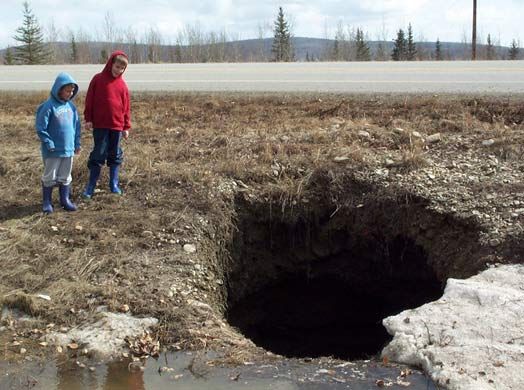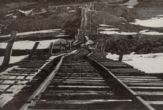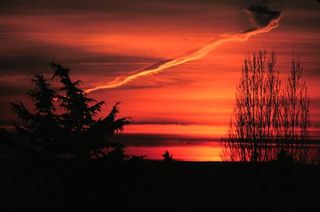Ground Frozen Since Ice Age Thaws and Collapses

Melting permafrost is damaging roads and buildings in Alaska and Russia and threatens to get much worse as the planet grows warmer, researchers said this week.
Up to 90 percent of the permafrost at the surface of the Northern Hemisphere could melt by the end of this century, leaving gaping holes in the ground and collapsed structures, roads and railways in northern regions.
In what scientists predict to be a vicious cycle, the thaw will release more greenhouse gases into the atmosphere, further exacerbating global warming.
The meltdown of northern soil is already underway. Other teams have noted sunken railways, damaged structures and increased numbers of rock-falls at high elevations owing to thawed boulders.
Getting worse
Permafrost is soil that remains frozen through summer. Even in regions where a surface "active layer" thaws seasonally, a deep layer of permafrost exists below and has been frozen since the last Ice Age.
Permafrost covers about a quarter of the Northern Hemisphere's land area.
Sign up for the Live Science daily newsletter now
Get the world’s most fascinating discoveries delivered straight to your inbox.
The top 10 feet (3 meters) or more of this perennially frozen soil could be decimated in the next few decades, altering ecosystems and causing damage across Canada, Alaska, and Russia, according to new computer simulations from the National Center for Atmospheric Research (NCAR).
By 2050, the topmost layer of permafrost could be gone across more than half this region, with 90 percent of it melted by 2100 [map].
"Thawing permafrost could send considerable amounts of water to the oceans," said study team member Andrew Slater of the University of Colorado's National Snow and Ice Data Center.
Water runoff to the Arctic has increased about 7 percent since the 1930s, Slater said. That could jump by up to 28 percent by the end of the century depending on the extent of greenhouse gas emissions which, according to a report today, are on the rise in the United States, which refuses to agree to an international plan to cut the output.
Early signs
Other studies have documented actual permafrost reductions already under way. Several researchers presented preliminary findings on the problem a year ago at a meeting of the American Geophysical Union.
Slater and NCAR's David Lawrence, who led the new study, reviewed some of the observed changes: Pocket of soil have collapsed in central Alaska, causing buckled highways, destabilized homes, forests with trees that lean at wild angles, and outright holes in the ground; industrial facilities in Siberia have reported significant damage.
The new work is the first to project future change in permafrost based on a global model that takes into account changes in the atmosphere, ocean, on land, and with sea ice and the overall effects on freezing and thawing in the soil.
The researchers also estimate that permafrost holds up to 30 percent of the world's carbon. As the ground melts, it could put more greenhouse gas into the atmosphere than what is produced by burning fossil fuels.
"If the permafrost does thaw, as our model predicts, it could have a major influence on climate," Lawrence said.
The study, announced yesterday, is detailed in the Dec. 17 issue of the journal Geophysical Research Letters.
- Report: 2005 Will Be Hottest, Stormiest
- You Decide: Is Global Warming the Top Science Story of 2005?
- How Global Warming is Changing the Wild Kingdom
- Greenland is Shrinking at Surprising Rate
- Natural Disasters: Top 10 U.S. Threats

Observed Effects of Melting Permafrost

Longer Airline Flights Proposed to Combat Global Warming
No Stopping it Now: Seas to Rise 4 Inches or More this Century
Internet Project Concludes Planet Could Warm by Nearly 20 Degrees
Robert is an independent health and science journalist and writer based in Phoenix, Arizona. He is a former editor-in-chief of Live Science with over 20 years of experience as a reporter and editor. He has worked on websites such as Space.com and Tom's Guide, and is a contributor on Medium, covering how we age and how to optimize the mind and body through time. He has a journalism degree from Humboldt State University in California.












